
|
Sale 98
The Pre-Long Beach Auction June 4-7, 2017
| Lot |
Photo |
Description |
Realized |
Lot 2838 |
 |
German States: Brunswick-Wolfenbüttel. Second Bell Taler, 1643-HS. Dav-6366A. August The Younger, 1604-1666. Half bust left. Reverse; Bell. Toned. NGC graded AU-55. Estimate Value $400 - 500
View details and enlarged photos
| Realized
$599 |
Lot 2839 |
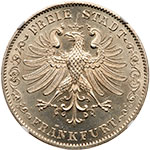 |
German States: Frankfurt am Main. 2 Talers, 1841. Dav-641; KM-329; Thun-131. Crowned eagle. Reverse; Value and date within wreath. Sharply struck with reflective fields and choice brilliant mint luster. NGC graded MS-64. Estimate Value $750 - 850
View details and enlarged photos
| Realized
$1,175 |
Lot 2840 |
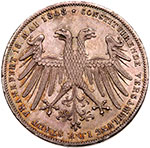 |
German States: Frankfurt am Main. 2 Gulden, 1848. Dav-643; KM-337. Constitutional Convention. Attractively toned. PCGS graded Genuine, Uncirculated, Details (Cleaning). Estimate Value $200 - 250
View details and enlarged photos
| Realized
$200 |
Lot 2841 |
 |
German States: Frankfurt am Main. 2 Talers, 1861. Dav-651; KM-365. Laureate bust right. Bright white luster. NCS graded About Uncirculated, Details (Improperly Cleaned). Estimate Value $75 - 100
View details and enlarged photos
| Realized
$153 |
Lot 2842 |
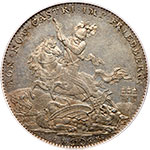 |
German States: Friedberg. Taler, 1804-GB(F)GH. Dav-655; KM-75; Thun-148. Johann Maria Rudolph. Crowned double headed eagle. Reverse; Knight on horseback slaying dragon. Faint adjustment marks in center. A lovely original mint lustrous example with reflective fields and good eye appeal. PCGS graded AU-55. WINGS. Estimate Value $1,000 - 1,200
View details and enlarged photos
| Unsold |
Lot 2843 |
 |
German States: Hamburg. 3 Marks, 1911-J. KM-620; J-64. Free City. Fully reflective brilliant fields. NGC graded Proof 66 Cameo. Estimate Value $400 - 500
View details and enlarged photos
| Realized
$793 |
Lot 2844 |
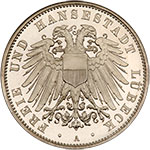 |
German States: Lübeck. 3 Mark, 1912-A. KM-215; J-82. Free City. Brilliant reflective fields. NGC graded Proof 64 Cameo. WINGS. Estimate Value $300 - 350
View details and enlarged photos
| Realized
$517 |
Lot 2845 |
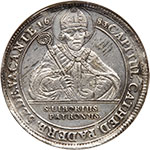 |
German States: Paderborn. Taler, 1683. Dav-5706; KM-324. Sede Vacante. St. Liborius holding crozier. Reverse; Charlemagne holding orb and scepter. Couple of scratches. Reflective fields, lustrous with attractive toning. Very Scarce type. NGC graded About Uncirculated, Details (Mount Removed). Estimate Value $1,500 - 2,000
View details and enlarged photos
| Unsold |
Lot 2846 |
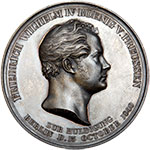 |
German States: Prussia. Silver Medal, 1840. 42 mm. By K. Fischer. On the Coronation of Frierich Wilhelm as King. Proof-like. Toned. Uncirculated. Estimate Value $100 - 125
View details and enlarged photos
| Realized
$353 |
Lot 2847 |
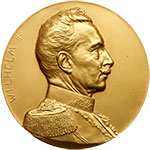 |
German States: Prussia. Large Gilt-Bronze Medal, ND. Wilhelm II (Reigned 1888-1918 abdicated at end of 1st World War) Large intricate gold-coated medal by celebrated medallist R. Marschall. 90 mm. Obverse king right in uniform. Reverse imperial German eagle. Exquisite detail on this portrait of the last German king. Probably made around 1916 the medal could have been a design or pattern for a coinage series as the obverse portrait and reverse coat of arms is similar to that featured on the gold and silver currency coinage which ended in 1915 during the First World War. Uncirculated. Estimate Value $500 - 600
View details and enlarged photos
| Realized
$517 |
Lot 2848 |
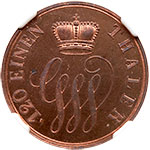 |
German States: Schaumburg-Lippe. 3 Pfennig, 1858-A. KM-41. Georg Wilhelm. Crowned monogram. NGC graded Proof 64 Red & Brown. WINGS. Estimate Value $150 - 200
View details and enlarged photos
| Realized
$165 |
Lot 2849 |
 |
German States: Schwarzburg-Sondershausen. 2 Marks, 1905. KM-153; J-169a. Thin rim variety. Karl Gunther. For the 25th Anniversary of Reign. A choice brilliant mint state example. NGC graded MS-65. WINGS. Estimate Value $175 - 225
View details and enlarged photos
| Realized
$259 |
Lot 2850 |
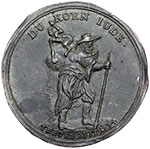 |
Germany. Lead Striking of Korn Jede Medal, 1694. Goppel-1211; FuS-4149. 34 mm. 11.7 grams. Uniface. By C. Wermuth. Jewish merchant walking right, carrying a sack of corn, a devil tears the sack releasing a cascade of corn to the ground. Reverse; Blank. Edge flaws. Very Fine. Estimate Value $100 - 200
View details and enlarged photos
| Realized
$60 |
Lot 2851 |
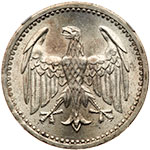 |
Germany. 3 Mark, 1924-A. KM-43. Denomination and date. Reverse; Eagle. NGC graded MS-64. Estimate Value $100 - 125
View details and enlarged photos
| Realized
$65 |
Lot 2852 |
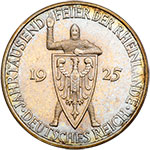 |
Germany. 5 Reichsmark, 1925-J. KM-47. Rhineland. Toned. About Extremely Fine. Estimate Value $100 - 125
View details and enlarged photos
| Realized
$118 |
Lot 2853 |
 |
Germany. 3 Reichsmark, 1927-A. KM-50; J-325. 100th Anniversary of Bremerhaven. Brilliant Proof. Estimate Value $300 - 350
View details and enlarged photos
| Realized
$317 |
Lot 2854 |
|
Germany. 3 Reichsmark's lot of Weimar: 1929-A (2), D, E, F, G (2), J. KM-63; J-340. Weimar Constitution. Lot of 8 coins. Very Fine to About Uncirculated. Estimate Value $250 - 300
View details
| Realized
$270 |
Lot 2855 |
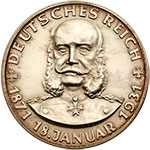 |
Germany. Medal, 1931. Silver. 21.9 grams. Edge: ST. SACHS.M 900f. For 60 Years of the German Empire. Wilhelm I, 1871 18 January 1931. Matte surface. Uncirculated. Estimate Value $100 - 125
View details and enlarged photos
| Realized
$82 |
Lot 2856 |
 |
Germany. Medal, 1931. Kienast-457. Silver. 37 mm. By Karl Goetz. The Founder and the Protector of the Reich. Prince von Bismarck 1871 and Paul von Hinderburg, 1931. Almost Uncirculated to Uncirculated. Estimate Value $100 - 125
View details and enlarged photos
| Realized
$153 |
Lot 2857 |
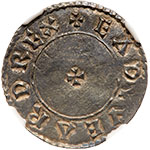 |
Great Britain. Penny, ND. S.1087. Edward the Elder, 899-924. Obverse; Small cross with King's name around. Reverse; Moneyer's details in two lines. Sharp lettering. A scarce coin which is practically as struck. A hint of blue toning. NGC graded AU-55. WINGS. Estimate Value $800 - 900
View details and enlarged photos
| Realized
$1,175 |
Lot 2858 |
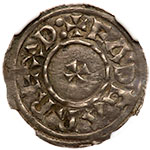 |
Great Britain. Penny, ND. S.1129; North-741. Eadgar, 959-975. Moneyer, Heriger. Small cross within circle. Reverse; Moneyer's name in two lines, cross between. Sharply struck and toned. NGC graded EF-45. WINGS. Estimate Value $600 - 800
View details and enlarged photos
| Realized
$823 |
Lot 2859 |
 |
Great Britain. Penny, ND. S.1146. Aethelred II, 978-1016. Second Hand type. Diademed bust right, with scepter. Reverse; Hand of profidence. London mint. Moneyer, Ealhstan. Couple of reverse peck marks. Toned. NGC graded AU-55. WINGS. Estimate Value $200 - 250
View details and enlarged photos
| Realized
$447 |
Lot 2860 |
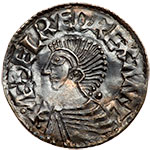 |
Great Britain. Penny, ND. S.1151. Aethelred II, 978-1016. Long Cross type. London mint. Leofnod, moneyer. A few peck marks. Toned. Extremely Fine. Estimate Value $200 - 250
View details and enlarged photos
| Realized
$306 |
Lot 2861 |
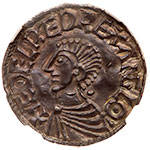 |
Great Britain. Penny, ND. S.1151. Aethelred II, 978-1016. Winchester mint. Moneyer, Wulfnoth. Long Cross type. Bust left. Reverse; Long cross. NGC graded About Uncirculated, Details (Peck Marked). Estimate Value $175 - 225
View details and enlarged photos
| Realized
$306 |
Lot 2862 |
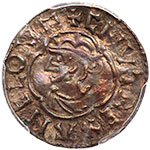 |
Great Britain. Penny, ND. S.1157. Cnut, 1016-1035. Quatrefoil type. Crowned bust left. Flan crack to center. Deeply toned. PCGS graded AU-58. WINGS. Estimate Value $250 - 300
View details and enlarged photos
| Realized
$247 |
Lot 2863 |
 |
Great Britain. Penny, ND. S.1158. Cnut, 1016-1035. Pointed Helmet type. Dover mint. Moneyer, Cinsige. Toned. NGC graded AU-55. Estimate Value $200 - 250
View details and enlarged photos
| Realized
$282 |
Lot 2864 |
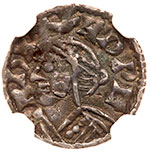 |
Great Britain. Penny, ND. S.1175. Edward The Confessor, 1042-1066. Small flan type. Canterbury mint. Moneyer, Manna. Flan cracks. Toned. NGC graded AU-53. WINGS. Estimate Value $200 - 250
View details and enlarged photos
| Realized
$247 |
Lot 2865 |
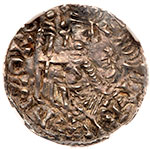 |
Great Britain. Penny, ND. S.1181. Edward The Confessor, 1042-1066. Sovereign/Eagles type. York mint. Moneyer, Ulfcetel. Double striking. Toned. NGC graded AU-55. Estimate Value $200 - 250
View details and enlarged photos
| Realized
$400 |
Lot 2866 |
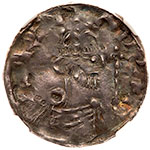 |
Great Britain. Penny, ND. S.1182. Edward The Confessor, 1042-1066. Hammer Cross type. Canterbury mint. Moneyer, Eadward. EADPARD ON CAENT. Somewhat blunder legend. Toned. NGC graded EF-45. Estimate Value $175 - 225
View details and enlarged photos
| Realized
$317 |
Lot 2867 |
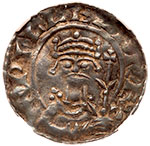 |
Great Britain. Penny, ND. S.1257. William I, The Conqueror, 1066-1087. Paxs type. Dover mint. Moneyer, Lifwine. Toned. NGC graded AU-55. WINGS. Estimate Value $400 - 500
View details and enlarged photos
| Realized
$734 |
Lot 2868 |
 |
Great Britain. Penny, ND. S.1345. 1.45 grams. Henry II, 1154-1189. London mint. Moneyer, Raul. NGC graded AU-50. WINGS. Estimate Value $150 - 200
View details and enlarged photos
| Realized
$235 |
Lot 2869 |
 |
Great Britain. Groat, ND. S.1875. 3.60 grams. Henry VI, First Reign, 1422-1461. Pinecone-mascle issue (1431-3). Calais mint. NGC graded EF-45. Estimate Value $150 - 200
View details and enlarged photos
| Realized
$259 |
Lot 2870 |
 |
Great Britain. Groat, ND. S.1908. Henry VI, 1422-1461. Trefoil issue, 1438-43. London mint. Facing bust. Bold strike and attractively toned. NGC graded EF-45. WINGS. Estimate Value $250 - 300
View details and enlarged photos
| Realized
$247 |
Lot 2871 |
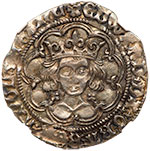 |
Great Britain. Groat, ND. S.1997. Edward IV, 1461-1485. Light coinage, 1464-70. Quartrefoils at ncek. London mint. Mintmark, rose. Facing bust. Toned. NGC graded AU-53. WINGS. Estimate Value $300 - 350
View details and enlarged photos
| Realized
$247 |
Lot 2872 |
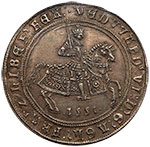 |
Great Britain. Crown, 1551. S-2478; N-1933; Lingford dies E10; Dav-8245. Edward VI, 1547-1553. Third period. Fine-silver issue. Initial or mint mark Y. Obverse: King crowned wearing armor holding a sword over his shoulder and galloping right on a richly caparisoned horse, date 1551 below. Reverse: Long cross fourchée over royal shield. England's first dated silver crown, boldly and evenly struck, apparently multiple times, on a wonderful, broad flan, with choice surfaces featuring splendid old-cabinet toning. Believed to be the finest known example, with a fabulous provenance. NGC graded MS-63. WINGS. Estimate Value $75,000 - 100,000
Ex: Bartlett-Gerard (1787), Southgate-Tyssen (1802), Edmonds (1834), Durrant (1847), Sparkes (1880), Brice (1887, as "matchless in any collection"), Montagu (1896 (quote from the Montagu Sale, Second Portion, in brilliant condition, "This coin has been considered to be the finest specimen known."), Murdoch (1903), Lingford (1950), and Slaney (2003).
Growing up in the shadow of his famous father, Henry VIII, young Edward Tudor faced a daunting, uncertain future. He was the only male heir to the throne of England, the son of Henry's third wife, Jane Seymour, who herself died while giving birth to him in October 1537. His grandfather had founded the family dynasty. His boisterous father had split with the Church of Rome for the sole purpose of creating a son to take the throne, and in so doing had exploited and executed women who had not managed to produce a son, the next Tudor king. All eyes were upon him, and many were not admiring eyes. Of perilous intrigue at Court, Shakespeare would explain it succinctly, writing of Henry as King Lear thus: "Who loses and who wins; who's in, who's out; and take upon us the mystery of things, as if we were God's spies: and we'll wear out, in a walled prison." But the boy had been sickly most of his life, and was already worn out when he became king in 1547, at the age of nine. His rule of England was a guise. He was ruled by covetous counselors, and so was his kingdom.
The nobles who controlled him used their positions in order to weaken the Crown, and increase their own authorities. His uncle, the Earl of Hertford, got the king's Council to declare himself to be Protector of the Realm; he then declared himself to be the Duke of Somerset. He rewarded his treasonous comrades with estates and elevated titles. They had set the stage to take away the Crown. They wanted the boy-king dead, but little Edward, while pale and thin, was highly intelligent. Inflation was now wracking the kingdom, thanks to his father's ruinous spending. The Scots were difficult to handle. Religious squabbling was always a trap, and Somerset erred. Edward watched as his Council made poor decisions in war and at Court. By the fall of 1551, they fell from grace and were judged treasonous, a capital offense. In January 1552, Edward coolly recorded in his diary of the man who had tried to seize his kingdom: "Today the Duke of Somerset had his head cut off on Tower Hill."
The king's new advisor was John Dudley, Earl of Warwick. He aligned himself with the fiercely Protestant young king, who elevated his title to Duke of Northumberland. The age-old Catholic faith was gradually falling across the country. The new Council supported and wanted Edward to thrive, at least for a while. Nobody wanted his sister, Princess Mary, a Catholic, and next in line of succession, to become queen. When another noble's daughter, Lady Jane Grey, married Northumberland's available son in May 1553, the outlines of a plot became clear, but the plot would not hatch. It needed time. King Edward VI was now sixteen years old, and very ill with tuberculosis. Six weeks after, he died, leaving his kingdom to his sister Mary.
While Edward VI had insufficient time to make much of a mark upon history, his royal mint's officials were hard at work restoring the quality of the gold and silver money of the realm which had been left in such a debased state, of poor intrinsic worth, at the end of his father Henry's monarchy. During the third and last period of the coinage, commencing in 1550, confidence had been restored in the king's money. Previously, the largest silver coin had been the shilling, called a Testone in the mid-1540s. It was of such poor quality that it had acquired a nickname, as had its issuer, "Old Copper-nose," as it showed Henry VIII facing, and the silver easily wore off to expose the base metal beneath. Those coins perished within a decade, and by 1551 the silver content was of such high quality that a brand-new denomination was issued, for the first time ever in England, a silver Crown. It depicted an armored sovereign on an armored war horse, with the date 1551 boldly placed beneath the image of power. Its silver content was nearly four times the quality of the previous silver coins, and it was intended to be accepted as good, hard money both at home and in foreign trade. Judging by the worn appearance of most surviving examples, Edward's silver crowns succeeded in their intended purpose.
In the exquisite specimen presented in this lot, we see perhaps the finest possible image of this first silver crown. This large coin represented 5-shillings' worth of value; it offered a bold image of authority. This coin clearly never entered circulation. When it was last described for auction in the Slaney Collection sold in London on May 15, 2003, as Lot 20, the normally reticent British cataloguer opined that other well-preserved examples of 1551 crowns "do not exhibit the almost medallic quality of this specimen, which would have required several precise blows of the hammer to achieve," going on even to suggest that "it might be tempting to regard this coin as a proof striking" except that both obverse and reverse dies are normal currency dies. It was further called "a perfect specimen, deeply toned, beautifully struck and in exceptionally high relief, believed to be the finest known." So, somehow it was spared from commercial use, probably kept by a wealthy admirer of the Tudors, possibly by a friend of the ill-fated, young king. But was it an especially minted piece, meant to be saved for posterity? The Slaney sale cataloguer concluded that "It is probable that this example is a currency piece which has been struck with unusual care for presentation purposes." We have no historical document to support its presentation status, but the coin is a testament to its own importance.
View details and enlarged photos
| Realized
$141,000 |
Lot 2873 |
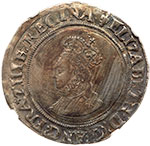 |
Great Britain. Shilling, ND. S.2549. Elizabeth I, 1558-1603. First issue, mint mark lis. Wire line and beaded inner circles. Obverse crowned portrait of queen, reverse quartered shield of arms. A rare shilling type issued in the first couple of years (1558-1560) of the queen's long reign. Compares well with the Spink plate coin, and catalogues at over $1300 in VF, no higher grade priced. NGC graded EF-40. Estimate Value $900 - 1,000
View details and enlarged photos
| Realized
$1,116 |
Lot 2874 |
 |
Great Britain. Shilling, ND. S.2555A. Elizabeth I, 1558-1603. Second issue. Mintmark, Cross crosslet (1560-1). Slight irregular edge at top. Sharply struck and toned. NGC graded EF-45. Estimate Value $800 - 1,000
View details and enlarged photos
| Realized
$852 |
Lot 2875 |
 |
Great Britain. Groat, ND. S.2556. Elizabeth I, 1558-1601. Second Issue. Mint mark cross crosslet. Sharply struck and attractively toned in shades of gunmetal grey and blue, this scarce coin has a great portrait of the Virgin Queen. Produced in the period 1560-1561, but undated, it is nearly as struck. NGC graded About Uncirculated, Details (Surface Hairlines). Estimate Value $550 - 650
View details and enlarged photos
| Realized
$646 |
Lot 2876 |
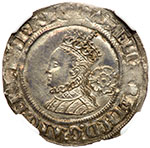 |
Great Britain. Sixpence, 1567. S.2562. Elizabeth I, 1558-1603. Third & Fourth issue. Mint mark, Lion. Obverse, crowned portrait of queen with Tudor rose behind. Reverse, quartered shield of arms with date above. Mint state and with probably the most sharply defined bust of Elizabeth we have seen. NGC graded MS-62. WINGS. Estimate Value $900 - 1,000
View details and enlarged photos
| Realized
$1,175 |
Lot 2877 |
 |
Great Britain. Crown, Undated. S.2652; Dav-3759. James I, 1604-1625. Second coinage. Mintmark, lis (1604-5). King on horseback right. Reverse; Framed arms. Toned. NGC graded VF-25. Estimate Value $1,500 - 1,700
View details and enlarged photos
| Realized
$1,880 |
Lot 2878 |
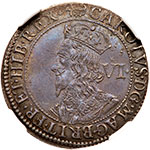 |
Great Britain. Briot Sixpence, ND. S.2860. Charles I, 1625-1649. Nicholas Briot's coinage, Second Milled issue (1638-9). Obverse; Detailed portrait of king left. Reverse; Square topped shield of arms. Mint mask anchor. Well struck with a delightful blue tone. As struck mint state and rare thus. NGC graded MS-63. WINGS. Estimate Value $750 - 850
View details and enlarged photos
| Realized
$1,880 |
Lot 2879 |
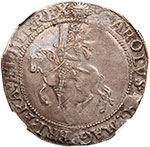 |
Great Britain. Halfcrown, ND. S.2778. Charles I, 1625-1649. Tower mint under Parliament. Mint mark sun over eye/eye (1645-46). This coin is unusual in that the I in CHRISTO is larger than the other letters. Group 3, type 3a. Struck on a ample flan with a pleasing pastel tone and a well-struck horseman. A nice example of what is normally a crudely made coin from the bleak ear of England's only Civil War. NGC graded AU-50. Estimate Value $300 - 400
View details and enlarged photos
| Realized
$341 |
Lot 2880 |
 |
Great Britain. Crown, 1644. S.3058; Dav-3765. Charles I, 1625-1649. Mintmark rose for Exeter mint. King on horseback left. Reverse; Oval arms. Toned. NGC graded VF-30. WINGS. Estimate Value $1,000 - 1,200
View details and enlarged photos
| Realized
$1,704 |
Lot 2881 |
|
Withdrawn
| Unsold |
Lot 2882 |
 |
Great Britain. Crown, 1653. S.3214; ESC-6; Dav-3772. Commonwealth, 1649-1660. Obverse; English shield of arms within wreath, mint mark sun. THE COMMONWEALTH OF ENGLAND. Reverse; Conjoined shields with mark of value above and Cromwellian motto: GOD WITH US. Practically mint state, and an exceptionally rare coin in this grade. The stippled areas of the crosses on the shields are intact, and this specimen has a handsome blue and grey toning. Usual slightly irregular flan which is normal for this date. NGC graded AU-58. WINGS. Estimate Value $7,000 - 9,000
View details and enlarged photos
| Realized
$6,169 |
Lot 2883 |
 |
Great Britain. Crown, 1658/7. S.3226; ESC-10; L&S-1; Dav-3773. By Thomas Simon. Oliver Cromwell, 1653-1660. Laureate bust of Cromwell left. Reverse; Crowned shield of the Protectorate. Inscribed edge. Superbly struck; with exquisite old-cabinet toning, steel blue over reflective fields. Usual die-crack across the base of the portrait. A stunning specimen and among the finest known. NGC graded MS-64 Prooflike. WINGS. Estimate Value $15,000 - 20,000
When Charles Stuart was crowned at Westminster Cathedral on February 2, 1626, attended by hundreds of lords and admirers watching the majestic ceremony, the farthest thought he could have had was that an unambitious, obscure country gentleman would one day challenge, and then terminate, his inherited role as King Charles I of England. And yet that is precisely what happened.
He had been born on the eve of the year 1600, and by all accounts he grew up to be a quiet man of refined tastes. He knew several languages, loved music and dramatic plays, was studious and devoted to collecting fine art. He was a dignified man. He never expected to be king but that role fell into his lap when his older brother, Prince Henry, died in childhood in 1612.
While even tempered, King Charles also believed absolutely in his divine right to rule, and soon he began quarreling with members of his Parliament over royal prerogatives. Schemes were launched against him; some included his closest friend, George Villiers, Duke of Buckingham. The king continued to insist that his powers were not the business of Parliament: they had been given to him by God. A few months after he ascended the throne, he further irritated many at Court by marrying Henrietta Maria of France, a 15-year-old Catholic princess. Three years later, Villiers was murdered by a fanatic, leaving Charles without his closest confidant. In fact, it was a horror which the king barely survived. They were more than close.
Parliamentarians objected to Charles's lavish spending on art and artists (as patron), and across his realm commoners began to despise him for raising taxes to pay for art and to wage war on old enemies. The king's quiet disposition was now seen as arrogance. By 1629, he was ruling alone, having dismissed Parliament for the fourth time. His religious stance evolved into repression, and it caused both Catholics and Puritans to sail to the American colonies, in search of a new life. But the Scots would not emigrate, and in Ireland rebellion was a household word. What had begun as a peaceful transition in the monarchy had become a king at odds with his subjects at large. At Court, he had loyal attendants. Elsewhere, treason was at hand. War loomed.
Following the rise of unrest in Scotland, the king was forced to call parliament back into session to raise funds for war. Then late in 1641 he faced military insurrection in Ireland. His powers were finally challenged when, quarreling again with parliament, he attempted to have five legislators arrested. In 1642, civil war broke out in England. The king faced enemies at home, in Scotland and in Ireland. His hold on the Crown was so insecure that he fled London, making Oxford his new headquarters. The nation was divided, and in tatters. An Irish army landed in the northwest. A Scottish army moved ever more southward. In the homeland, the Puritans who opposed the king selected one of their own, a country gentleman, to lead their army. His name was Oliver Cromwell. His surprising military skills revealed themselves in battle after battle, routing the king and his dwindling army to the point that the monarch began hiding in orchards, in ditches, and even in priest's holes. His dispirited army, stretched thin and fragmented, began surrendering. The end was approaching.
All the while, King Charles's financing appeared as coinage made at various temporary mints, and was often made from silverware, or plate-some donated, some seized. The civil war was arduous. Four years into it, Charles surrendered to the Scots, who turned him over to his enemies in Parliament. Their general, Oliver Cromwell, defeated all lingering royalist resistance within a year. The civil war ended. Charles was imprisoned. Early in 1649, Parliament set up a new High Court of Justice. The captured king's trial as a "tyrant, traitor, murderer, and public enemy" began on January 20. He listened to his accusers but refused to plead before commoners except to call them lawless. On the 27th, the court found him guilty and sentenced him to death. He was beheaded on a scaffold set up in Whitehall, at the very center of his former kingdom, on January 30, 1649, with a single blow from a sword. His last words were these: "I go from a corruptible to an incorruptible Crown, where no disturbance can be."
Now lacking a king, the nation entered an interregnum called the Commonwealth of England, initially including Wales and eventually Scotland and Ireland. For some time, fighting continued here and there around the former kingdom, now called a republic. The new Parliament, in which full power was vested, became a place more of arguing than of governing. New money was issued using the traditional hammered method, pieces of thin gold and silver bearing the legend The Commonwealth of England. Each coin also claimed "God With Us." These were minted primarily from 1649 through 1657, although a few later-dated pieces occur. But the money's claims disguised the reality that the nation was essentially ungoverned and in chaos. Reforms were delayed. A hoped-for new constitution stalled. Law and order returned only at the close of 1653 when the Army Council at last produced England's first written constitution, called the Instrument of Government. It appointed Oliver Cromwell, the former general, as The Lord Protector of England. He governed essentially as a dictator, although following the laws of the constitution and its revision in 1657.
Among the finest mementoes of the brief period of English history known as The Protectorate was the era's equivalent of advertising its authority to rule, a new kind of coinage made by an imported minting method. Each coin depicted "the Great Emancipator" facing left with a laurel wreath on his head, and an especially elegant crowned shield on its reverse. Never before had Englishmen seen such coins, such elegant money. The most talented engraver of his day, Thomas Simon, created the images. The coins were struck using mechanical presses, and these produced bold, beautifully detailed images. The coins advertised that a new government had arrived, proclaimed on gleaming new coins! But all too soon the Protector died of natural causes. Within two years of the first appearance of Cromwell's money, what remained of the Commonwealth dissolved again into chaos, lacking a leader. The executed king's son returned from exile in France in 1660, and the monarchy was restored. No former supporters of the Commonwealth wanted to be seen as other than loyal to the new king, Charles II, and least of all did the king's subjects wish to be found in possession of any of the money made without royal consent. Some coins issued during 1649-1658 went into hiding. Most were destroyed. Almost none survived in sparkling, pristine condition, as seen on this fabulous crown-one of the finest known examples of the coins of Oliver Cromwell, the Lord Protector.
View details and enlarged photos
| Realized
$34,075 |
Lot 2884 |
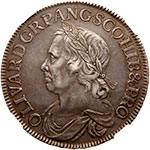 |
Great Britain. Crown, 1658/7. S.3226; ESC-10; Dav-3773. Oliver Cromwell. Laureate and draped bust left. Reverse; Crowned arms. Usual die flaw. Attractive toning. NGC graded AU-55. WINGS. Estimate Value $5,000 - 6,000
View details and enlarged photos
| Realized
$4,994 |
Lot 2885 |
 |
Great Britain. Halfcrown, 1658. S.3227A; ESC-447. Oliver Cromwell. Obverse; Laureate draped bust of the Lord Protector left. Reverse; Crowned shield of the Protectorate. Edge PAX QVAERITVR BELLO. Deeply toned, prooflike mint state. Rare this nice. PCGS graded MS-64. WINGS. Estimate Value $6,000 - 8,000
View details and enlarged photos
| Realized
$13,513 |
Lot 2886 |
 |
Great Britain. Shilling, 1658. S.3228; ESC-1005. Oliver Cromwell. Obverse; Portrait of the Lord Protector. Reverse; Crowned shield. Grained edge. A well struck coin with good surfaces and sharp detail. A popular denomination. NGC graded MS-62. WINGS. Estimate Value $5,000 - 5,500
View details and enlarged photos
| Realized
$4,348 |
Lot 2887 |
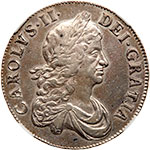 |
Great Britain. Crown, 1668. S.3357; ESC-36; Dav-3775. Charles II. Second bust. Edge, VICESIMO. Laureate bust right. NGC graded About Uncirculated, Details (Excessive Surface Hairlines). Estimate Value $800 - 1,000
View details and enlarged photos
| Realized
$969 |
|
|